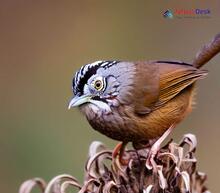Nestled amidst the towering Himalayas, Nepal is a haven for nature enthusiasts and bird lovers alike. Boasting over 900 recorded bird species, this South Asian country presents a treasure trove of unique avian life waiting to be discovered. Among these fascinating creatures is the Stachyris genus, an often-overlooked group of birds that deserves recognition for their distinctive attributes and ecological significance. In this blog post, we delve into the captivating world of the Stachyris genus and its presence in Nepal.
Getting to Know the Stachyris
Birds belonging to the Stachyris genus are part of the Timaliidae family, commonly known as babblers or timaliids. This family comprises small to medium-sized birds characterized by their strong legs, stout bills, and mainly plain plumage. Although primarily found in Asia, their distribution extends across several countries, with Nepal being one of their most charming habitats.
Appearance of these Quirky Feathered Friends
Most Stachyris species are small birds, measuring approximately 10-15 centimeters in length. They typically showcase drab colors such as brown or grey on the upper parts and light tones like white or buff on their underparts. Some species may have more striking patterns or markings. Despite their seemingly unremarkable coloration, these birds exhibit curious behavior and intricate vocalizations that contribute to their charm.
Where to Find Stachyris in Nepal
Within Nepal's diverse ecosystems, Stachyris bird species can be spotted in subtropical and montane forests across different altitudes. They predominantly prefer dense vegetation within these forested areas which provide them ample cover and feeding grounds.
Ecology and Behavior: A Peek into the Lives of Stachyris Birds
These elusive birds thrive across various habitats and exhibit a wide array of feeding habits, depending upon the available resources. They primarily consume insects, larvae, seeds, and fruits but may fall back to other small invertebrates as alternatives. The Stachyris' foraging technique involves methodically scanning the environment and probing their bills into crevices to extract hidden insects.
An engaging aspect of their behavior is their social nature. Stachyris species often form mixed-species flocks with other Timaliidae members or birds from different families to mutually enhance foraging success and predator vigilance.
Conservation and Ecotourism: Appreciating the Stachyris Genus
Although these birds may not compete with Nepal's colorful flagship species like the Himalayan Monal or Spiny Babbler in terms of appearance, their ecological significance cannot be underestimated. The Stachyris genus contributes to maintaining ecological balance through insect control while simultaneously offering food resources for predator species within their habitat.
As eco-tourism gains popularity in Nepal, appreciating the beauty of lesser-known bird species like those belonging to the Stachyris genus proves essential. Not only does this enhance the birdwatching experience but also fosters a deeper understanding and love for Nepal’s vast biodiversity.
In conclusion, the obscure yet fascinating Stachyris genus offers an intriguing dimension to Nepal's vibrant avian population. By shedding light on these birds, we can deepen our appreciation for nature's captivating tapestry and promote sustainable ecotourism practices that prioritize conserving biodiversity.




